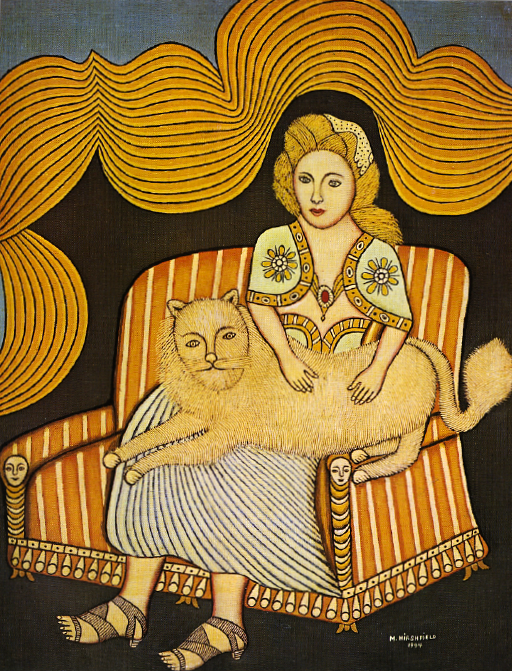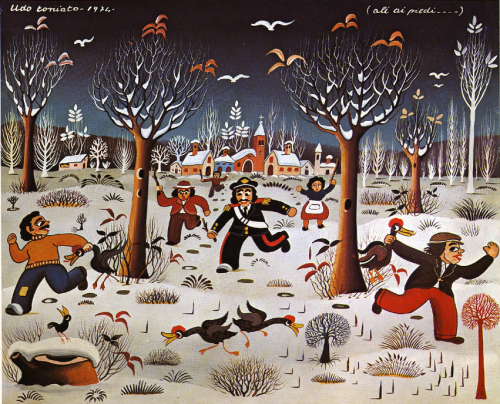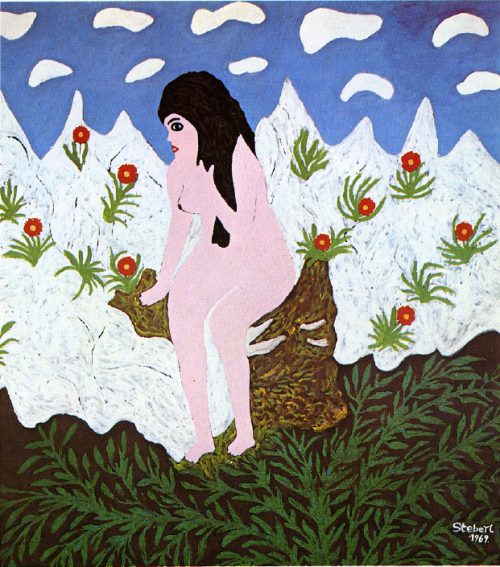“Rousseau was categorically convinced of the existence of vampires.” –David Markson
So I’ve been thinking a lot on naive art, a term people don’t use no more, and how it relates to writing. Rousseau is talked at a lot in Markson’s This is not a novel, the main character of which is named Writer. It’s hard to tell though, which one he’s talking about — Henri or Jean-Jacques — unless of course you know who Le Douanier was. It’s interesting too to think on the distinction(s) between folk art, outsider art, primitive art, and the art of children or the mentally ill. Because there is a difference apparently according to Anatole Jakovsky and other people at least there was, the differences some of them anyway being that naive artists produce a color palette which is harmonious if different from that of the usual whatever. The compositions are balanced and interesting, even inspired, but not executed as people are taught in art school. I don’t buy this.
But I would buy this.
“When I was their age I could draw like Raphael. But it took me a lifetime to draw like they do.
Said Picasso at an exhibition of children’s art.”
— David Markson
Some people have different opinions on what is naive art and who is naive and what is naive, the main thing seems to be a childlike view of the world. I can get down with that I guess.
But basically naive painters come to their own conclusions on the same issues everyone has before them, and they work. This is the important thing: they work. Their conclusions do work.
Can’t the same be said of all the great writers? Who would say that Faulkner, Joyce, Stein, Beckett, or Genet (just to name a few), didn’t all come their own conclusions about literature? And those conclusions worked. Isn’t that the general idea? There weren’t always MFA programs. But even if one does the MFA, is it the teachers that make a great? I don’t think so.
If you’re on that wagon, maybe you’ll hop on this one too: Great writers operate on the basis of immense naïveté. Otherwise, I don’t see how they could do what they do. They have to simultaneously negate everyone else’s existence while admitting exactly the same. Anyways, let’s talk about another Gertrude for once, Gertrude O’Brady.
Gertrude O’Brady is (or was) “regarded as the greatest naive painter after Rousseau” (Anatole Jakovsky, Naive Painting). Sadly, there is very little about her on the web. Which means, let’s face it, she’s so far forgotten. She painted for only a few years, during which she produced sixty paintings of such rare quality they were later compared to the work of “Clouet, Fouquet, even Holbein.” (I know, right? (?)) She was, for a short time, the American darling of the Parisian art scene. Then one day she stopped painting, her anemia returned, and the traces of paperwork trail away to dust as she was transferred from clinic to clinic. “A veritable meteor!” exclaims Jakovsky.
Gertrude liked playing the piano and wearing her hair in braids.
In 1938 she lit out for Spain to fight the fascists, but never got there. By the time she reached Paris her anemia was so serious that she had to go to bed. She whiled away a long convalescence by taking up art. Soon she became infatuated with the 1900s, combed the bookstalls for period prints to paint from. When the Nazis arrived and put her in Vittel concentration camp, she had achieved her first goal: simple escape pictures that almost anyone could escape into.
“It’s very hard to explain how you can suddenly become a painter, especially for me—I talk like a Spanish cow—but my life absolutely changed from that minute. I started painting 12 and 15 hours a day. I never went to the cafés; I lost all my friends. When the war started I thought, ‘Let the bombs fall. They won’t fall on me; I have too much work to do.'”
Manhattan critics were not that enthusiastic about her first Manhattan show, which opened last week, but they liked it. The surrealist touches which spiced her earlier works had disappeared. Her new gouaches were tightly painted and mostly recognizable glimpses of empty Paris courtyards and old-fashioned shop fronts, looking rather like backdrops for an intimate vaudeville show. Every cobblestone was separately outlined, and the shop signs were painstakingly lettered in.
“Now I want to travel around the country,” said Artist O’Brady. “Also I’ll have to visit Evanston. Papa—he’s 84 now—is still spouting steam because I’m a painter.” In Evanston, Gertrude O’Brady would be remembered as a blonde girl named McBrady (she modified her name to make it easier for the French to pronounce). Now, at 43, she sometimes fumbles English words, her braids are red instead of blonde, and she has made art-loving Paris take her work and like it.
“Le Douanier Rousseau once informed Picasso that they two were the two greatest living painters:
I in the modern style and you in the Egyptian.”
— David Markson

Louis Dechelette, "The Brothers Trouille, Acrobats"
Had they known of him, would Henry Darger have been called a naive artist? Some would say he’s folk. Others an outsider. I would say who gives a fuck if it’s good it’s good it’s good it’s fresh forever.
Tags: david markson, gertrude o'brady, naive art, rousseau, vampires
















I love this. ‘Naive’ is such a weird label you’re right, but it lets us talk about this, so has its uses. Too early for more response than this.
This post kicks a lot of ass, Reynard. Thanks for it.
If you ever find yourself in Baltimore, there’s a really cool museum of outsider art there: http://www.avam.org/
Nice one, Reynard. Louis Dechelette’s “The Brothers Trouille, Acrobats” reminds me of some of the new leipzig school of painting: http://www.nytimes.com/2006/01/08/magazine/08leipzig.html
Time and place is a bitch.
Last night, in fact, I was reading Markson’s THIS IS NOT A NOVEL. Wonderful post.
Surely you are familiar with the Bay Area Holy Triumvirate: Creative Growth, Creativity Explored and NIAD, Reynard.
If not, go see!
good stuff, thanks for introducing me to gertrude o’brady. i can’t stop looking at “the balloon”
who are yall favorite outsider writers
i’m stoked you guys are into vampires too
“Because there is a difference apparently according to Anatole Jakovsky and other people at least there was, the differences some of them anyway being that naive artists produce a color palette which is harmonious if different from that of the usual whatever.”
Was this post written in an intentionally “naive” style, or just extraordinarily poorly?
yes
Was this reply written in an intentionally “naive” style, or just extraordinarily poorly?
no
i’ve always been partial to the free jack ads http://www.ubu.com/outsiders/jack.html but there are others on the ubu thing, especially check out francis e. dec http://en.wikipedia.org/wiki/Francis_E._Dec
Somebody take his crayons away.
What a great post! Thanks for introducing me to Gertrude O’Brady.
i’ve peeped francis e dec’s shit
seems sweet
el-p quotes him on his verse on the new das racist mixtape
thanks for that ubu link